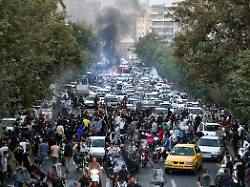State television reports 17 dead
Protests in Iran more brutal – mullahs throttle internet
09/22/2022, 5:00 p.m
The death of 22-year-old Masha Amini has sparked further violent clashes between demonstrators and security authorities in Iran. State television admits 17 deaths. After the mullah regime throttled the internet, brutality increased.
At least 17 people have died in protests and unrest in dozens of Iranian cities. Both security forces and demonstrators were among the victims, state television reported in the afternoon. Further details were not given. In numerous cities, demonstrators fought again during the night with security forces, who, according to eyewitnesses, acted harshly after massive restrictions on the internet. Shots with live ammunition are reported on videos that could not be verified.
The protests were triggered by the death of 22-year-old Iranian Mahsa Amini. She was arrested by the Morality Police just over a week ago for violating the strict Islamic dress code. What exactly happened to Amini after her arrest is unclear. Anyway, she went into a coma and died in a hospital on Friday. Critics accuse the morality police of using violence. The police deny the allegations. Since then, thousands of people have been demonstrating across the country against the government’s repressive course.
Hacker attack on central bank
Iran’s central bank, meanwhile, confirmed a cyber attack on its systems. The Iranian news agency Tasnim reported that the bank had become the target of a DDoS attack. In DDoS attacks, attackers overwhelm their victims’ servers with a flood of data requests in order to paralyze them. In Iran, the website was available again after some time. The hacker group Anonymous claimed responsibility for the attack in a Telegram channel, citing their solidarity with the protests in Iran as the reason. The central bank’s website was down worldwide, according to verification tools on the internet. Government sites are also said to be the target of a broad-based attack.
In the meantime, prominent Iranians in exile have shown solidarity with the protest movement. In Iran, too, voices were raised that opposed the government’s course in an unusually sharp manner. Soccer star Ali Karimi, for example, showed solidarity with the protests. The ex-professional received encouragement from many Iranians. “Don’t be afraid of strong women. Maybe the day will come when they will be your only army,” wrote the ex-professional, who was also committed to the Bundesliga in the past, on Twitter.
However, the Internet in the country is massively restricted and mobile networks in particular are largely switched off. Instagram, one of the last free social networks, was also blocked. Some high-reach Iranian news portals that had reported on the protests could no longer be reached abroad. The demonstrations were rarely discussed on the websites of the state media. The government, for its part, called for counter-demonstrations after Friday prayers.
Interview scandal with Raisi
Since the Islamic Revolution in 1979, Iran’s ruling mullahs’ regime has enforced strict dress codes. In the big cities in particular, many women now see the rules as rather relaxed and, for example, only wear their headscarves on the back of their heads – to the annoyance of ultra-conservative politicians. Religious hardliners in parliament have been trying for months to have Islamic laws applied more strictly.
Christiane Amanpour, longtime correspondent for the US broadcaster CNN, reported that she had planned an interview with Iran’s President Ebrahim Raisi on the sidelines of the UN General Assembly in New York on the protests. However, Raisi did not appear at the agreed time. Instead, one of Raisi’s aides came 40 minutes later and said the President was proposing that Amanpour wear a headscarf. She refused, Amanpour tweeted. No Iranian president has previously required wearing a headscarf when interviewed outside of Iran. Raisis’ employee explained that the headscarf was a question of respect and referred to the situation in Iran.
